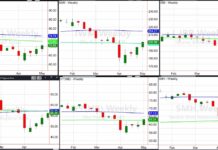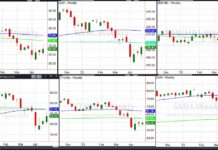 By Ross Heart
By Ross Heart
A few weeks back I mentioned to See It Market founder Andy Nyquist that I was working on a post detailing the #1 risk to Apple. Well, a quick slide in shares from $700 to $505 brought a rash of hurried “Demise of Apple” articles, and piling on with the consensus isn’t my style. Now that we’ve seen a strong rebound off the lows, I’ll revisit as I think the company is at, or nearing, a crossroads meriting explanation.
Quick disclosures – this post is entirely about Apple the corporation. It will not attempt to correlate consumer trends to Apple’s current stock price or timing its market horizon. And, to be sure, I should note that I have recently been short shares of Apple in addition to having held multiple long positions; so I have traded both sides. At the time of this writing, however, I do not hold a position in Apple. Regardless, I do have the utmost respect and admiration for the innovation, creativity and brilliance of Steve Jobs and what he and their current team have meant for all of us.
So, Just What Is Apple’s Biggest Risk?
Generational Pushback. This is obviously long-term, but given how rapid technology’s pace runs, perhaps it isn’t. Sure Amazon and Google are risks, a less robust upgrade cycle and cannibalizing its own products are concerns, attacks on profit margins may exist, but long-term what matters most are the outsized trends like the one that drove Apple to its current perch.
So, what do I mean by Generational Pushback? Both Mom and Dad use an iPhone, Mom uses her MacBook Air to work at home, Dad jams to classic rock on his iPod while mowing the lawn, all the while the kids play on their iPads after coming home from a school that uses Apple products. First of all, that is one heck of a business! The pushback occurs as kids age, products age, and all of a sudden, one day Mom’s MacBook Air starts to look a lot like Grandma’s Oldsmobile to a restless 15-year old who isn’t sure following Mom and Dad’s technology footprint is so cool anymore.
This doesn’t take place immediately as the shine of revolutionary products, productivity advantages, and outstanding design will persist for quite some time. If I were a long-term shareholder though, obsessing over quarterly metrics, anticipating new product launches, and wondering how much thinner the product can get wouldn’t concern me nearly as much as the day kids eventually start to say no to the $500B behemoth. Kids are a fickle bunch, and at some point when trends start to wane and when successful substitutes emerge, a trend in technology can accelerate as quickly in reverse. I believe staving off those encroaching competitors is exactly the reason Apple has grown so aggressive recently in protecting their intellectual property and design advantages.
Why focus on kids/youth? Because they will always (almost always) dictate the trend and adoption of transformations in technology, music, and the like. Apple exploited this truth as they strategically set their sights on younger demographics and the college-aged crowd initially. They then parlayed a successful adoption of product with incredibly easy-to-use technology into a proxy for older generations to become hip once again, to tap into their youth. Imagine listening to Dylan back in the 60’s as a rebellious teenager, and Dad discovers Dylan’s music and bursts into your room with his own copy of the latest vinyl. Then you visit your Grandfather at Thanksgiving and he’s spinning his own record on his console stereo system (which doubles nicely as furniture, mind you). Need I say more? I believe wholeheartedly that Apple’s successful penetration of these markets is exactly why it currently teeters at this precipice.
Why is this generational pushback my biggest concern? Because Apple needs new product innovation to retain its leadership, and if the youngest generations do not embrace new ventures going forward, they will not gain traction, and the company cannot continue its growth regardless the current obsessions by more mature customers. Apple is the greatest and most successful consumer company we’ve ever witnessed, but they are not immune to the same factors that have brought many a technology company to their knees (ironically, a list that once included Apple).
I believe this tapping into youth and hipsterness is exactly the reason many Apple supporters are so feverishly defensive of Apple criticisms as the company connects its older users with a youthful spirit like no company ever has. It is the cherry red sports car a Baby Boomer can hold in their hand, text their kids with when they’re away at college, and reminisce to the Beatles with. To question the dominance of that car is a direct strike at its fountain of youth whereas a 14-year old won’t bat an eye when Apple’s reign is over. They’ll already have the next great thing down on their Christmas list.
Ironically, if kids roll over and don’t push back we may not get that next great thing, and it would be a terrible indicator for the future of the United States. We need innovation, we need pushback, we need competition, and we especially need outcast kids tinkering in garages and basements with dreams of taking on the king of the mountain. I cringe if we get to a point where we obsess over the established Apple, Zuck and Sergey, but scoff at those outcast kids as silly dreamers. We desperately need those kids more than ever. As that famous push-backer once sang, The Times They Are A-Changin’.
Disclosure: At the time of this writing Heart Capital did not hold any positions in Apple.
Heart Capital does not offer investment advice via this medium. Under no circumstance whatsoever do these postings, opinions, charts, or any other information represent a recommendation or personalized investment, tax, or financial planning advice.
—————————————————————-
Twitter: @heartcapital and @seeitmarket Facebook: See It Market
Any opinions expressed herein are solely those of the author, and do not in any way represent the views or opinions of any other person or entity.








